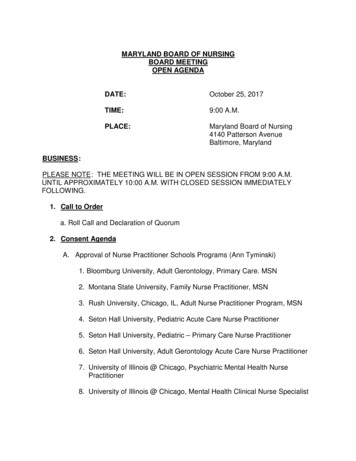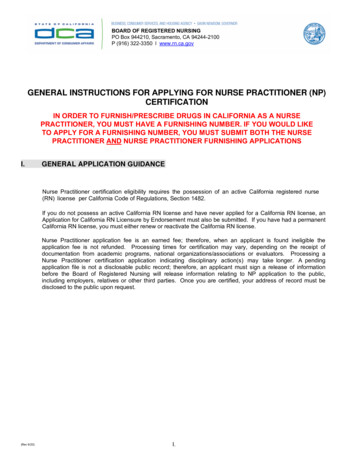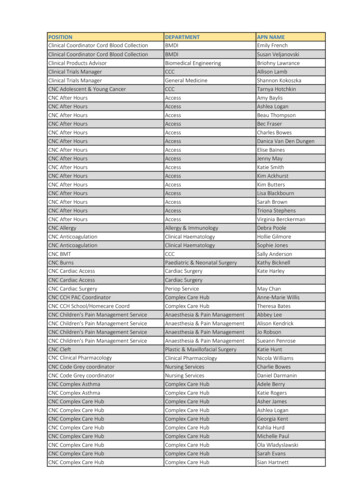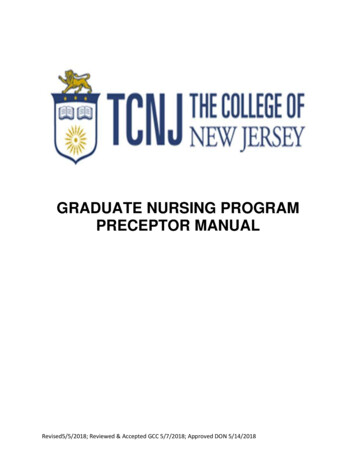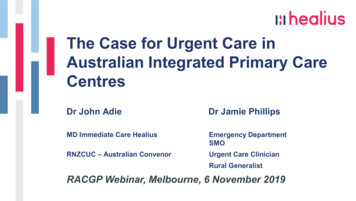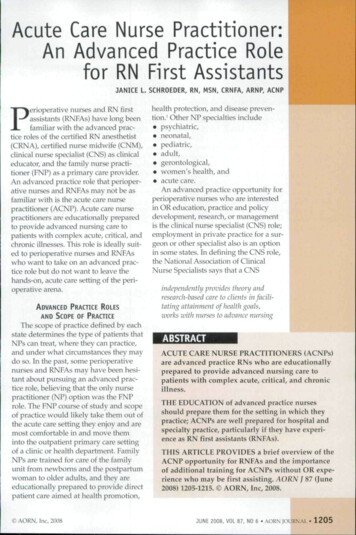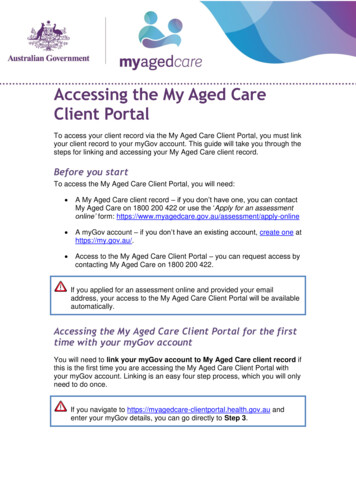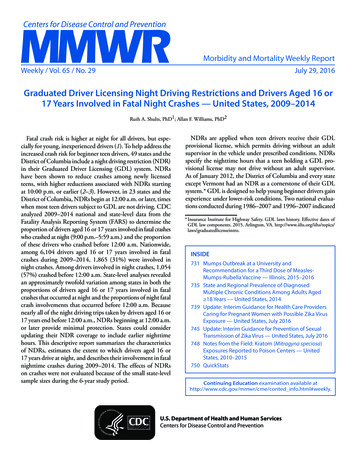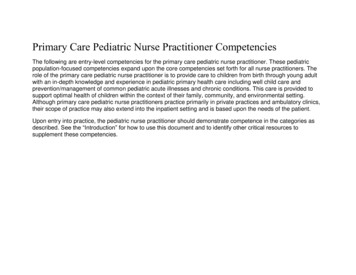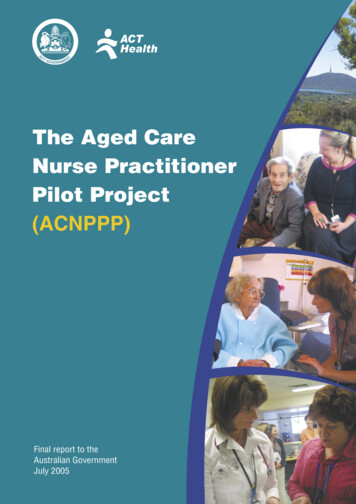
Transcription
The Aged CareNurse PractitionerPilot Project(ACNPPP)Final report to theAustralian GovernmentJuly 2005
The Aged CareNurse PractitionerPilot Project(ACNPPP)Final report to theAustralian GovernmentJuly 2005
ACT Government 2005This work is copyright. Apartfrom any use as permittedunder the Copyright Act 1968,no part may be reproducedby any process without priorwritten permission from the ACTDepartment of Health, GPO Box825, Canberra ACT 2601.Reprinted: February 2006isbn: 0 642 60346 4
Letter to the Chief Executive OfficerDear Dr SherbonIt is with great pleasure that I present the completed report for a jointACT Health and Commonwealth initiative titled the Aged Care NursePractitioner Pilot Project.The report represents the culmination of twelve months of consultation,debate, planning and research by a wide range of ACT stakeholdersto explore an innovative strategy to address the needs of the aged carecommunity, including improved service access and increased flexibility inmodels of health care delivery. To achieve these aims requires a collaborativehealth workforce focused on meeting the changing needs of the ACTpopulation.Presented in the report is the role that aged care nurse practitioners mayplay across the ACT Health system. Aged care nurse practitioner modelswere examined across the continuum of care in the acute, community andresidential aged care settings. The models were examined to identify whichmodel(s) of care would enhance the delivery of efficient and effective healthcare and produce quality outcomes.The models were tested within a framework of close support from amultidisciplinary clinical support team. The report details the methodologyand findings of the project and presents recommendations that support theformal implementation of the aged care nurse practitioner level of servicein the ACT Health care system. Additionally the report provides valuableinformation and data that will be of national significance and inform thedevelopment of the role of nurse practitioner in Australia.I would like to take this opportunity to commend the report to you forconsideration.Yours sincerelyAdjunct Professor Jenny BeutelACT Chief NurseChair, Steering CommitteeAged Care Nurse Practitioner Pilot ProjectACT Health31 July 2005THE AGED CARE NURSE PRACTITIONER PILOT PROJECT (ACNPPP): FINAL REPORTiii
ivTHE AGED CARE NURSE PRACTITIONER PILOT PROJECT (ACNPPP): FINAL REPORT
Table of contentsLetter to Chief Executive OfficeriiiForewordviiAcknowledgmentsixMembership of the committees of the Aged Care Nurse Practitioner Pilot ProjectxGlossaryxiiList of acronymsxivPart 1 Executive summary and recommendations11.1 Background21.2 Overview31.3 The Aged Care Nurse Practitioner Pilot Project41.4 Executive summary61.5 Recommendations of the ACT Health ACNPPP final report8Part 2 Report on the Aged CareNurse Practitioner Pilot Project11L I T E R AT U R E R E V I E W2.1 Impact of an ageing population13Aged care is a growing issue13Barriers to meeting older client’s needs13Potential role for aged care nurse practitioner152.2 Nurse practitioners16International perspectives16National perspectives17Summary272.3 Nurse practitioner level of service in Australia29Role and scope of practice29Dynamic practice30Professional efficacy30Clinical leadership31Summary32METHODOLOGY3.1 Background33Aims and objectives33Determination of terms and definitions333.2 Research approach35Study design35The governance framework35THE AGED CARE NURSE PRACTITIONER PILOT PROJECT (ACNPPP): FINAL REPORTv
3.3 Process for Aged Care Nurse Practitioner Pilot Project39Phase 1: Recruitment39Phase 2: Educational preparation, clinical practice and clinical rotations39Phase 3: Data collection41Limitations of the project methodology45OUTCOMES AND DISCUSSION4.1 Qualitative findings47Surveys51Overall summary544.2 Quantitative results551 Derivation of the sample552 Overview of episodes of care, investigations, interventions and referrals574.4 Discussion of findings62Part 3 References and appendices655.1 References665.2 Appendices71Data collection tools71AClient data71BConsultation details72C Clinical review73D Clinical outcome74Interview scheduleStudent nurse practitionerFocus group questions757576Student nurse practitioner76Clinical support team77Survey forms78Clinical survey team78Service area81Client84Consent forms87Client/power of attorney87Staff90Information sheetsClients9292Letter to residential aged care facility94Staff96Poster98Terms of referenceCentral clinical coordinating teamClinical support teamsvi47Interviews and focus groups9999101Frequently asked questions104Aged care clinical practice guidelines and medication formulary110University of Canberra nurse practitioner handbook for clinical support teams133Newsletters150THE AGED CARE NURSE PRACTITIONER PILOT PROJECT (ACNPPP): FINAL REPORT
ForewordNurses and midwives within the Australian Capital Territory (ACT) are providing high qualitycare to the people of Canberra and its surrounding regions. The development of the nursepractitioner role offers the potential for even greater contribution through the provision ofan innovative and new level of service. The nurse practitioner level of service is one that isclinically focused and provides feasible, responsive and safe health care delivered within acollaborative and consultative framework and resulting in high levels of client satisfaction.Australia, like many other countries, is facing unprecedented challenges in the provision ofhealth care. Escalating health care costs, an ageing population, changing models of healthcare delivery, shifting professional role boundaries and the increasing scope of postgraduatenurse education are factors that have contributed to the development of advanced practiceroles for nursing. The most recent advanced practice role is that of the nurse practitioner.The nurse practitioner role has been the subject of extensive discussion in the internationalliterature over the last 20 years, since nurse practitioners were introduced into Canada andthe United States of America (US) in primary health care settings. The primary rationalesstated for developing nurse practitioner roles is that the role provides a strategy to respondto existing inadequacies in timely access to care and that the role meets the health needs ofpopulations more effectively. These benefits are particularly evident in settings where thedemand for services exceeds the current availability of health professionals. The pressureson health care provision, especially in relation to the issues confronting the aged care sector,have resulted in pressure to re-think present models and adopt innovative approaches thatare flexible and fulfil changing health care demands.The development and implementation of the nurse practitioner role is in keeping withstrategies being developed internationally and elsewhere in Australia.Recognising the increasing importance of issues confronting the aged care health system,the Australian Government (the Minister for Ageing, the Hon Kevin Andrews), proposedthat the way forward may be to conduct and evaluate a demonstration project involving atrial of practice of nurse practitioners in aged care that examined the potential benefits,barriers and challenges for the nurse practitioner role in this field. The ACT was onejurisdiction interested in contributing to this national agenda and the Aged Care NursePractitioner Pilot Project (ACNPPP) was developed.The ACNPPP builds on the recommendations and lessons learnt from the initial NursePractitioner Trial conducted in the ACT during 2000–2001 (ACT Government 2002). Thisprecursor trial provided important research evidence that contributed to the developmentof a masters level qualification for nurse practitioners within the ACT, and recommendedamendments to key pieces of government legislation to introduce the nurse practitionerrole as a legitimate and autonomous member of the multidisciplinary health care team.These recommendations are now in place.The ACNPPP has been a collaborative partnership between ACT Health and the AustralianGovernment as represented by the Department of Health and Ageing. The project hasinvestigated the potential of three nurse practitioner models across the acute, communityand residential aged care settings in delivering a level of service to enhance the quality ofaged care service provision, addressing the needs of both individuals and the aged carehealth community, including their need for diverse options in health care, responsiveness,improved service access, care coordination and increased flexibility in models of healthTHE AGED CARE NURSE PRACTITIONER PILOT PROJECT (ACNPPP): FINAL REPORTvii
care delivery. To achieve this level of optimal care requires a collaborative and integratedapproach. The research has demonstrated that this is the case.I would like to acknowledge the dedicated efforts of the many people, including the healthprofessionals, experts, researchers and consumers who have contributed to the Aged CareNurse Practitioner Pilot Project and final report.The aged care nurse practitioner role in the ACT supports an exciting, innovativecollaborative model of aged care health service delivery and I look forward to itsimplementation.I would like to take this opportunity to commend the Aged Care Nurse Practitioner Pilot Project:Final Report to you in the knowledge that the document will become a valuable resource forthe development of the nurse practitioner role within the aged care environment.Dr Tony SherbonChief Executive OfficerACT HealthviiiTHE AGED CARE NURSE PRACTITIONER PILOT PROJECT (ACNPPP): FINAL REPORT
AcknowledgmentsWe would like to acknowledge with gratitude the efforts of many people and organisationsthat have contributed to the information in the final report of the Aged Care NursePractitioner Pilot Project. Their time, expertise, knowledge and commitment is appreciated,in particular:1 Members of the steering committee, clinical support teams, the central clinicalcoordinating team and expert group, and the investigating team for their support,comments and feedback to guide the project to its successful conclusion.2 Professor Glenn Gardner and her research team for the pioneering work in the firstprecursor trial of nurse practitioners in the ACT.3 The student nurse practitioners who participated in the project and who collaborativelydeveloped the clinical practice guidelines and medication formularies with their clinicalsupport teams. The data that they provided from their interactions with clients andother health professionals formed the core data that allowed the investigators to drawconclusions and recommendations.4 Dr Jan Taylor and Ms Elissa O’Keefe, course conveners for the Master of NursePractitioner program, University of Canberra.5 The organisations that provided clinical placements for the student nurse practitioner Baptist Community Services Morling Lodge Centre for Aged Care The Canberra Hospital Calvary Health Care Community Health GP practices in the ACT.6 The states of New South Wales, Victoria, South Australia and Queensland who haveundertaken previous investigations in nurse practitioner projects/trials.THE AGED CARE NURSE PRACTITIONER PILOT PROJECT (ACNPPP): FINAL REPORTix
Membership of the committees of the Aged CareNurse Practitioner Pilot ProjectSteering committeeJenny Beutel ChairACT Health, Nursing and Midwifery Office,Adjunct Professor and ACT Chief NurseSonia Hogan Secretariat Aged Care Nurse Practitioner Pilot Project, Project ManagerPaul ArbonResearch Centre for Nursing and Midwifery Practice:The Canberra Hospital and the University of Canberra,Chair of Acute Care Nursing and Director of the RCNMPRichard BialkowskiACT Division of General Practice, Chief Executive OfficerMelanie DicksAged & Community Services Association of NSW & ACT Inc.Grant Carey-Ide*ACT Health, Community Health and Director, Continuing Care,Principal NurseMark GaukrogerACT Health, Continuing Care Program, Nursing ManagerKaren Murphyand Jennie BakerACT Health, Allied Health AdvisorACT Health, Senior Officer, Office of the Allied Health AdvisorSue RichardsonACT Australian Medical Association (AMA), GeriatricianHelen SaundersCouncil of the Ageing, ACT BranchJoan ScottAged and Primary Care Policy Unit, ManagerMaria TrudingerAustralian Nursing Federation, ACT Branch, Branch Vice PresidentBernadette WalkerDepartment of Health and Ageing, Director, Workforce Support SectionClare WillingtonACT Health, General Practice AdvisorMaelyn WishartAged Care Advisory Council, Veteran communityHoward WrenACT Ambulance Service, Acting General Manager, Clinical ServicesInvestigative teamPaul Arbon ChiefInvestigator and ChairResearch Centre for Nursing and Midwifery Practice (RCNMP)Professor of Acute Care Nursing, Director of the RCNMPMarlene EggertResearch Centre for Nursing and Midwifery Practice,Senior Researcher, and Clinical Research FellowAnne GardnerCabrini Deakin Centre for Nursing Research,Associate Professor in NursingChristine PhillipsThe Academic Unit of General Practice and Community HealthSenior Lecturer, School of Medicine, Australian National UniversityMargaret ProctorAustralian Nursing and Midwifery Council,International Section Manager (position during project)Nicole Van DiemenMorshead Home, Chief Executive OfficerGordon WaddingtonUniversity of Canberra, Associate Professor and Head of PhysiotherapyProject support teamSonia HoganProject ManagerKasia BailResearch Assistant and Registered NurseKaren GravenmakerResearch Assistant and Registered Nurse* Previous membersxTHE AGED CARE NURSE PRACTITIONER PILOT PROJECT (ACNPPP): FINAL REPORT
Central clinical coordinating team and expert membersMarc Budge ChairThe Canberra Hospital, Geriatric Medicine, Associate ProfessorSonia Hogan Secretariat Project ManagerDebbie BoothMorling Lodge, Director of NursingBill StoneThe Canberra Hospital, Aged Care and Rehabilitation Services, DirectorCorinne TrevittUniversity of Canberra, Course Convener, Graduate Certificate inAged CareJulia PooleRoyal North Shore Hospital, Clinical Nurse ConsultantRosemary VagiJindalee aged care residence, Registered NurseMary Ann KulhThe Canberra Hospital, Geriatric Medicine, Staff OfficerRosemary KennedyThe Canberra Hospital, Nursing and Midwifery Director,Organisational DevelopmentExpert membersKaren Cook*Nurses Board of the ACT, ManagerCarol MircoNurse Board of the ACT, Acting ManagerGabrielle CooperUniversity of Canberra, Course Convener, PharmacyJulia PotterThe Canberra Hospital, Pathology, DirectorAnne ReedThe Canberra Hospital, Medical ImagingJane StrangACT Health, Chief Pharmacist, Pharmaceutical ServicesJan TaylorUniversity of Canberra, Course Convener, Master of Nurse PractitionerClinical support teamsAcute sectorMary Ann Ryall*The Canberra Hospital, Geriatric Medicine, GeriatricianBetty DomazetThe Canberra Hospital, Emergency Department, Emergency PhysicianMichael DavisThe Canberra Hospital, Geriatric Medicine, GeriatricianMarianne BellewThe Canberra Hospital, Falls Clinic, Clinical Nurse ConsultantChristine RyburnThe Canberra Hospital, PharmacistCommunityGrant Carey-IdeACT Health, Community Health and Director, Continuing Care,Principal NurseClare WillingtonACT Health, GP AdvisorMary Ann KulhThe Canberra Hospital Geriatric Medicine, Staff SpecialistJudy HumeACT Health, Social WorkerResidential sectorDebbie BoothBaptist Community Services, Morling Lodge Centre for Aged Care,Director of NursingJenny CarpenterBaptist Community Services, Morling Lodge Centre for Aged Care,Clinical EducatorSteve MendickGeneral Practitioner, Yarralumla Medical PracticeLauren Fitzpatrick*Baptist Community Services, Morling Lodge Centre for Aged Care,Nursing Manager* Previous membersTHE AGED CARE NURSE PRACTITIONER PILOT PROJECT (ACNPPP): FINAL REPORTxi
GlossaryAdvanced practice nursing defines a level of nursing practice that utilises extended andexpanded skills, experience and knowledge in assessment, planning, implementation,diagnosis and evaluation of the care required. Nurses practicing at this level areeducationally prepared at postgraduate level or equivalent, and may work in a specialistor generalist capacity. However, the basis of advanced practice is the high degree ofknowledge, skill and experience that is applied within the nurse-client relationship toachieve optimum outcomes through critical analysis, problem solving and accuratedecision-making. Nurses working at an advanced practice level are able to workautonomously, initiating the care process, as well as in collaboration with other healthcare professionals. Advanced practice nursing forms the basis for the role of the nursepractitioner (Royal College of Nursing Australia, Position Statement 2000).Authorisation is the approval by the nursing regulatory authority (for example, the NursesBoard of the ACT) of the scope of practice of the nurse practitioner in that jurisdiction.The authorisation process invests legal authority and responsibility on the personauthorised (ACT Government 2005).Autonomous practice involves being accountable for one’s own decisions and an awarenessof one’s professional boundaries, knowledge and abilities. Autonomous nursepractitioners make clinical decisions based upon their scope of practice (which identifiesthese boundaries and abilities). Nurse practitioners work as a collaborative member of amultidisciplinary team, and their accountability is inherent to their role.Collaborative practice involves multidisciplinary health care professionals and the client,family or carer jointly working together to provide coordinated, integrated care to clientsthrough shared goals, shared decision making and mutual respect.Clinical practice guidelines are systematically developed statements to assist the practitionerand consumer decisions about appropriate health care for specific clinical circumstances(National Health Medical Research Centre 1999).Clinical practice guidelines are a critical component of the scope of the nursepractitioners practice. They comprise an outline of the minimum accepted processesor elements that are considered necessary to incorporate into practice. Clinical practiceguidelines cover a range of common clinical presentations and provide a guide for thenurse practitioner in clinical assessment, clinical management, referral and clinicalevaluation to provide the most appropriate, safe and effective care. Guidelines are basedupon the current best available evidence of best practice and are outcome focused(ACT Government 2005).As part of the project, the student nurse practitioners developed a series of clinicalpractice guidelines that provide a mechanism for defining and communicating thescope of practice for the specific nurse practitioner model. These govern the agreedmedications, diagnostic tests, such as pathology and imaging that the nurse practitionermay order.Episode of care describes a new consultation for a health-related problem. The episodeof care ends when the health-related problem is resolved or concluded, or no longerrequires treatment.Extended nursing practice defines a level of nursing that utilises skills and knowledge in aspecific setting or specialty that is beyond the usual scope of nursing practice. ExtendedxiiTHE AGED CARE NURSE PRACTITIONER PILOT PROJECT (ACNPPP): FINAL REPORT
practice involves advanced clinical assessment including interpretation of diagnosticresults, implementing and monitoring therapeutic regimes including prescribingpharmacological interventions, and initiating and receiving appropriate referrals.This extended practice is conducted according to a nursing model of health andrequires appropriate legislative protection.Medication formulary is a list of the classifications of medications that a nurse practitionercan order from. The medication formulary has been collaboratively formed by thestudent nurse practitioners and the multidisciplinary team during the project andverified by an expert panel. The medication formulary is consistent with the relevantclinical practice guidelines that relate to the scope of practice for a specific nursepractitioner model (ACT Government 2002).A nurse practitioner is a registered nurse educated to function autonomously andcollaboratively in an advanced and extended clinical role. The nurse practitioner roleincludes assessment and management of clients using nursing knowledge and skillsand may include, but is not limited to, direct referral to other health care professionals,prescribing medications and ordering diagnostic investigations. The nurse practitionerrole is grounded in nursing professional values, knowledge, theories and practice andprovides innovative and flexible health care delivery that complements other health careproviders. The scope of the nurse practitioner is determined by the context in which thenurse practitioner is authorised to practice (Gardner et al. 2004).Nurse regulatory authority is the legally constituted body in each jurisdiction charged withthe regulation of nursing and professional practice. The main role of the regulatoryauthority is the protection of the public through ensuring that nurses/midwives areappropriately qualified and demonstrates an acceptable standard of practice (Gardner etal. 2004)Recommended medication refers to medications that the student nurse practitioner hasrecommended for administration in the care of their clients. Under the conditions ofthe project they were unable to prescribe; they therefore recommended medications thatwere prescribed by their medical clinical support team member and mentor.Scope of practice is the definition of the extent and the parameters of practice for a specificnurse practitioner model. The nurse practitioner is able to practice with autonomy anddiscretion within the specified scope of practice (ACT Government 2005).Student nurse practitioner is a term used throughout the period of the project to describethe experienced registered nurses who were undertaking the additional educationaltraining (Master of Nurse Practitioner) to be eligible for authorisation as a nursepractitioner (aged care).Visit is the consultation/s generated within an episode of care. Each single episode mayhave included a number of visits.THE AGED CARE NURSE PRACTITIONER PILOT PROJECT (ACNPPP): FINAL REPORTxiii
List of acronymsxivABSAustralian Bureau of StatisticsACNPPPAged Care Nurse Practitioner Pilot ProjectACTAustralian Capital TerritoryAHMACAustralian Health Ministers Advisory CouncilAIHWAustralian Institute of Health and WelfareAMAAustralian Medical AssociationANFAustralian Nurses FederationCPGClinical Practice GuidelinesDHHSDepartment of Health and Human Services (Tasmania)HICHealth Insurance CommissionGPGeneral practitionerICNInternational Council of NursesMBSMedicare Benefits ScheduleN3ETNational Nursing and Nursing Education TaskforceNBVNurses Board of VictoriaNCEPHNational Centre for Epidemiology and Population HealthNPNurse practitionerNPIACNurse Practitioner Implementation Advisory Committee (Victoria)NRBNurses Registration BoardNSWNew South WalesQLDQueenslandPBSPharmaceutical Benefits SchemeRCNRoyal College of NursingRCNARoyal College of Nursing AustraliaRCNMPResearch Centre for Nursing and Midwifery PracticeSASouth AustraliaSADHSSouth Australian Department of Human ServicesSNPStudent nurse practitionerTASTasmaniaTCHThe Canberra HospitalUCUniversity of CanberraUKUnited KingdomUSUnited States of AmericaVICVictoriaWAWestern AustraliaWHOWorld Health OrganizationTHE AGED CARE NURSE PRACTITIONER PILOT PROJECT (ACNPPP): FINAL REPORT
Part 1Executive summary andrecommendations1.1Background1.2OverviewKey milestonesAged care1.3The Aged Care NursePractitioner Pilot ProjectProject objectivesReport structure1.4Executive summary1.5Recommendations
1.1 BackgroundWhilst the development of the nurse practitioner role in Australia and New Zealand is still inan early stage, the international foundations of the role can be traced back to the 1960s and1970s when nurse practitioners were introduced in response to limited access to health careservices in primary health care settings in the United States (US), Canada and the UnitedKingdom (UK).In Australia and New Zealand the nurse practitioner role is still evolving as a new andunique level of health care provider (Gardner et al. 2004). The development of the role isinfluenced by differing health care agendas but with the principal emphasis focusing on thepotential benefits that nurse practitioners can provide in the delivery of health care services.The core factors that determine the nature of health services are related to the healthprevention, maintenance and illness care needs of the community. These needs are subjectto change in response to social, cultural and technological conditions, and the expectationsof the community. A responsive health service is therefore not a static commodity, but onethat incorporates diversity and flexibility in the face of ever- changing community needs(ACT Government 2002).Australia is facing significant progressive change in the demographics of the population.The effects of the ageing of the population, that begin in this decade, will continue for thenext five decades at least (Australian Government 2005). The prevalence of chronic andcomplex conditions will increase, as will the associated costs of healthcare. In addition, thesocial environment generates influences that result in sectors of the community not havingequitable access to health care either through lifestyle, economic, cultural or mobilityfactors. Contemporaneously, rapid scientific and technological advances are providing othersectors of the community with increased information and expectations of health serviceand disease management, whilst creating the conditions for increasing specialisation of thehealth care workforce (ACT Government 2002).The changing nature of health service is reflected in the shifting boundaries andrelationships of health care professionals. Current demands and systems cannot supportthe former hierarchical, individualistic and paternalistic processes that have characterisedthese relationships in the past, and no single health care provider can adequately meetthe complex requirements of the consumer. New approaches to health service emphasisemultidisciplinary, collaborative team approaches to care. The nurse practitioner has thepotential to make an important contribution to the collaborative team approach to healthservice (ACT Government 2002).In this environment, the nurse practitioner is emerging as a new level and type of healthservice. However, the full implementation of nurse practitioner roles remains unrealiseddespite the significant amount of international and national information from clinical andresearch data supporting the positive effects of the role. Studies suggest that nurse practitionersprovide a safe, accessible, responsive, and comprehensive service that demonstrates highlevels of consumer acceptance and satisfaction while supporting cost containment andpositive health outcomes (Brown et al. 1995, Spitzer et al. 1974, Reverly 1998).In recent years, there has been intense interest from health care providers, researchers,clinicians and developers of public policy especially within the various health departmentsin Australia focussing on the role of the nurse practitioner within the aged care system. TheACT has demonstrated an interest in, and a commitment to, a rigorous examination of thepotential for the nurse practitioner to play a role in the aged care system.2THE AGED CARE NURSE PRACTITIONER PILOT PROJECT (ACNPPP): FINAL REPORT
1.2 OverviewIn December 1999, the ACT Department of Health and Community Care (ACT Health) inconjunction with the Nurses Board of the ACT sponsored a comprehensive project to investigatethe nurse practitioner level of health service. The aims of this trial were to investigate thefeasibility, safety and efficacy of the nurse practitioner as a new level of health service in theACT health system. These roles offered new approaches to provide high quality health carefor people who did not have easy access to the health system. In so doing the ACT joined anational and international trend in exploring innovative approaches in delivery of healthservice to under serviced and marginalised consumer groups. The trial concluded in July2002 and the findings included:1 Recommendations to the Minister for Health supporting the inclusion of the nursepractitioner level of health care in the health system of the ACT.2 Development of three nurse practitioner models of practice in sexual health, mental healthand wound care, including practice protocols and medication formulary for each model.3 Development of a research derived Master of Nurse Practitioner curriculum at theUniversity of Canberra.4 Development of a validated process for investigating nurse practitioner models in anyspeciality or context of health care.Additionally, ACT Health (based on the experience of some other states and territories)identified the need, at the outset, to develop necessary systems and infrastructure to facilitatethe successful establishment of nurse practitioners in the ACT. Extensive preparatory work toestablish a safe and conducive environment, that appropriately supports nurse practitionerroles, has or is being completed.Key milestones1 Legislative amendments to provide a regulatory framework that protects the public andensures a high quality standard for service delivery.2 Introduction of a Master of Nurse Practitioner course at the University of Canberra.3 Consultation and development of an ACT nurse practitioner framework that providesguidelines and practical information for both prospective employers and those wishing tobecome nurse practitioners.4 Authorisation of the first two nurse practitioners in the ACT (sexual health, nephrology/renal).The development of the nurse practitioner role in the ACT is consistent with the directionsof other states and terr
4 Dr Jan Taylor and Ms Elissa O'Keefe, course conveners for the Master of Nurse Practitioner program, University of Canberra. 5 The organisations that provided clinical placements for the student nurse practitioner Baptist Community Services Morling Lodge Centre for Aged Care The Canberra Hospital Calvary Health Care Community Health GP practices in the ACT. 6 The states of New South Wales .


